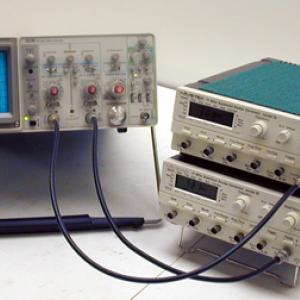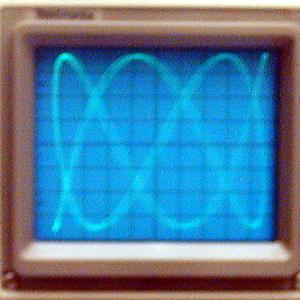College of Liberal Arts & Sciences
3A80.20 - Lissajous Figures - Oscilloscope
Plug one wave generator into each input of a dual trace scope. Set the oscilloscope to X - Y plotting. If each generator is at the same frequency the figure will be in the form of a circle. More complicated patterns will be obtained with higher harmonic frequencies. The Wavetek generators work much better for this because they are more stable and they also have a 'stabilization mode' so that you can lock onto a desired frequency.
- Tiandong Li, Ruotong Zhu, Huilin Jin, Hongchun Yang, Minghe Wu, Baohua Teng, "Further Understanding for Lissajous Figures", TPT, Vol. 59, #1, Jan. 2021, p. 62.
- C. Criado and N. Alamo, "A Simple Construction to Illustrate Lissajous Figures", TPT, Vol. 42, #4, April 2004, p. 248.
- E.Y.C. Tong, "Lissajous Figures", TPT, Vol. 35, # 8, p. 491- 493, Nov. 1997.
- Thomas B. Greenslade, "All About Lissajous Figures", TPT, Vol. 31, # 6, Sept. 1993, p. 364.
- Fred B. Otto, "Three-Dimensional Lissajous Figures", TPT, Vol. 29, # 4, Apr. 1991, p. 197.
- Arthur Quinton, "The Generator of Lissajous Figures", TPT, Vol. 16, # 3, Mar. 1978, p. 178.
- Frank G. Karioris, "Projection Sine-Sine Grid and Lissajous Figures", TPT, Vol. 13, # 5, May 1975, p. 294.
- Thomas B. Greenslade, Jr., "Lissajous Figures for Various Frequency Ratios and Different Phase Angles", AJP, Vol. 92, #10, Oct. 2024, p. 779.
- Thomas B. Greenslade, Jr., "Lissajous Figure Demonstrator (Photo)", AJP, Vol. 73, # 9, Sept. 2005, p. 892.
- P. Jasselette and J. Vandermeulen, "More on Lissajous Figures", AJP, 52, # 2, Feb. 1986.
- Mu-Shiang Wu, W. H. Tsai, "Corrections for Lissajous Figures in Books", AJP, 52, # 7, July 1984, p. 657.
- Sn- 2, 3: Freier and Anderson, A Demonstration Handbook for Physics.
- M-930: "Lissajous Patterns on Scope", DICK and RAE Physics Demo Notebook.
- Yaakov Kraftmakher, "1.5, Lissajous Patterns", Experiments and Demonstrations in Physics, ISBN 981-256-602-3, p. 20.
- 1.25: Charles Taylor, The Art and Science of Lecture Demonstration, p. 50- 52.
- Gerard L'E Turner, Nineteenth-Century Scientific Instruments, p. 145-146.
- The Project Physics Course - Teachers Resource Book, "Concepts of Motion", "Frequency Measurements," p. 120.
Disclaimer: These demonstrations are provided only for illustrative use by persons affiliated with The University of Iowa and only under the direction of a trained instructor or physicist. The University of Iowa is not responsible for demonstrations performed by those using their own equipment or who choose to use this reference material for their own purpose. The demonstrations included here are within the public domain and can be found in materials contained in libraries, bookstores, and through electronic sources. Performing all or any portion of any of these demonstrations, with or without revisions not depicted here entails inherent risks. These risks include, without limitation, bodily injury (and possibly death), including risks to health that may be temporary or permanent and that may exacerbate a pre-existing medical condition; and property loss or damage. Anyone performing any part of these demonstrations, even with revisions, knowingly and voluntarily assumes all risks associated with them.

